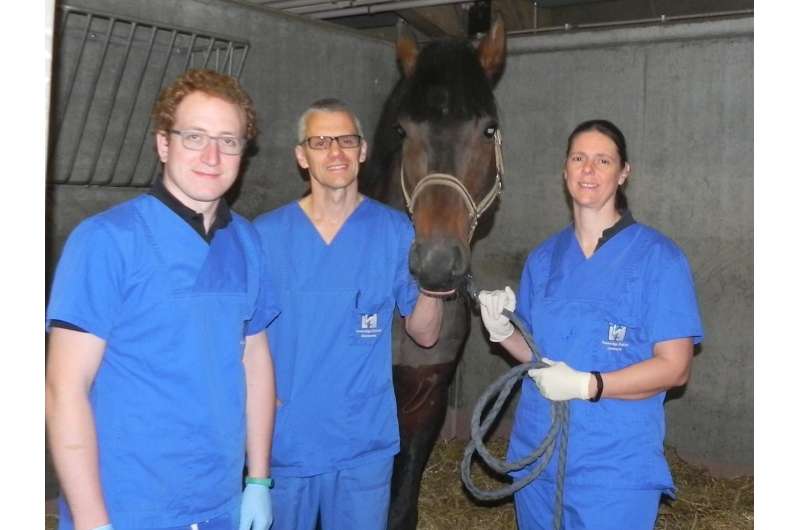First successful ablation of a cardiac arrhythmia in a horse

The Equine Cardioteam, led by Prof Gunther van Loon, has treated a Norwegian showjumper stallion with a cardiac arrhythmia by ablation. The horse had been successfully treated by electroshock therapy several times but showed recurrence each time.
Three-dimensional recording of all electrical activity in the heart, a technique called 'mapping' was first needed to find the precise spot in the heart where the arrhythmia originated from. Local destruction of the tissue by ablation (heating of tissue) subsequently restored the normal heart rhythm. Both techniques had so far never been done in horses partially because adult horses do not fit in a CT or MRI. The specialists from the Equine Cardioteam guided the whole procedure by cardiac ultrasound. "This is a world first and the technique opens broad perspectives for treatment of arrhythmias in horses or other large animals in future" says Professor van Loon.
Cardiac arrhythmias in horses
A cardiac arrhythmia is an electrical problem that causes the heart to beat irregularly. Abnormalities of the cardiac rhythm occur frequently in horses. Some are innocent but most arrhythmias do affect performance or might even be a risk for collapse or sudden death. Accurate diagnosis is therefore important. Anti-arrhythmic drugs may be used to attempt to restore a normal rhythm. The Equine Cardioteam also has a longstanding experience with pacemaker implantation in horses for arrhythmias that cause the heart to beat to slowly. Since 2001, at Ghent University, a novel treatment was developed to treat arrhythmias by electroshock. Nowadays, horses from all over Europe are being treated by electroshock therapy at Ghent University because of the high success rate of over 95%. Successfully treated horses, however, may show recurrence and may need a second treatment. This was also the case for the Norwegian showjumper who was successfully treated several times by electroshock therapy but each time the arrhythmia recurred.
In human medicine, it is well known that many patients experience recurrence of atrial arrhythmias. The reason is that specific 'diseased' groups of cells reinitiate the arrhythmia because they are electrically instable. Ablation, a technique that inactivates these diseased cells by heating or cooling, allows to dramatically reduce the risk for recurrence. Advanced imaging techniques such as CT and MRI are needed to exactly localize the ablation catheters in the heart.
Ablation in a horse
Ablation had, so far, never been done in horses. Horses are much too big for their thorax to fit in a CT or MRI. Therefore, the Equine Cardioteam guided the whole procedure of ablation by ultrasound. First, under general anaesthesia, a full 3D image of the atria with all electrical activation patterns was recorded by an advanced intracardiac 'mapping' technique. This examination allowed to identify the group of diseased cells that created the arrhythmia in this horse. Subsequently, an ablation catheter was guided to the right spot in the heart to destroy the diseased cells by ablation. Normal heart rhythm immediately resumed.
The operation took four hours. Recovery from anaesthesia was uneventful. The horse shows full recovery and is scheduled to return to sport soon.
Provided by Ghent University

















